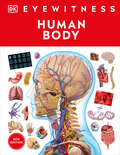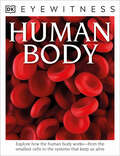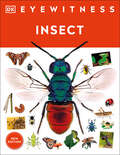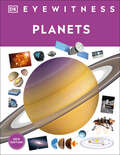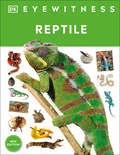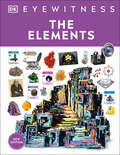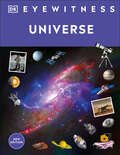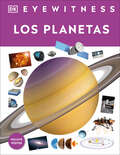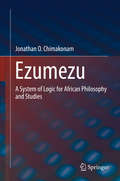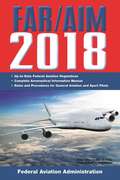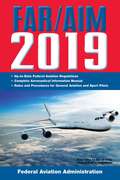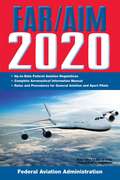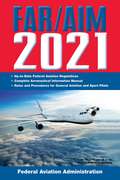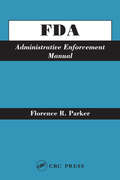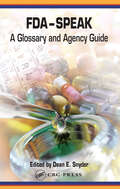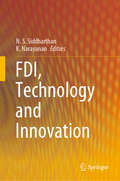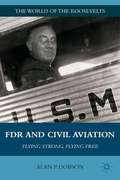- Table View
- List View
Eyewitness Human Body (DK Eyewitness)
by DKPacked with stunning photography, Eyewitness Human Body explores how the fascinating human body works.Become an eyewitness to the fascinating world of the human body, in this picture-led reference guide that will take you on a visual tour of our own bodies from the inside out. Children will be mesmerized as they travel through the amazing human body to learn about the brain centre, muscle power, bony frame, pumping heart, and senses hard at work interpreting and understanding our world. This unique, beautifully illustrated guide reveals processes you take for granted, such as breathing and eating, are shown using detailed illustrations and photography, and explained alongside incredible facts and figures. As you look through the body, you&’ll also learn about the history of our fascination with how the human body works. Using striking full-colour photographs and illustrations, discover the many complex and incredible systems that keep your body functioning throughout the day.Throughout the pages of this newly-revised book on our bodies, you can expect to find: - A fresh new look, new photographs, updated information, and a new &“eyewitness&” feature.- Amazing facts, updated diagrams, statistics, and timelines.- Brand new eyewitness accounts from experts in the field.Eyewitness Human Body introduces the ultimate guide to our bodies, packed with lots of infographics, statistics, facts, and timelines. This fun and interactive guide also comes with a giant fold-out wall chart crammed full of body bits and pieces. This all-emcompassing anatomy guide is a must-have for curious children aged 9+ with a thirst for learning, as well as teachers, parents and librarians.So, what&’s new? Part of DK&’s best-selling Eyewitness series, this popular title has been reinvigorated for the next generation of information-seekers and stay-at-home explorers, with a fresh new look, up to 20 percent new images, including photography and updated diagrams, updated information, and a new &“eyewitness&” feature with fascinating first-hand accounts from experts in the field.Explore the series!Globally, the Eyewitness series has sold more than 50 million copies over 30 years. Journey down the River Amazon and explore the rainforest with Eyewitness Amazon, learn how to combat climate change with Eyewitness Climate Change or take a trip aboard the most famous ship in history with Eyewitness Titanic.
Eyewitness Human Body: Explore How the Human Body Works—from the Smallest Cells to the Systems That Kee (DK Eyewitness)
by Richard WalkerThe most trusted nonfiction series on the market, Eyewitness Books provide an in-depth, comprehensive look at their subjects with a unique integration of words and pictures. Completely revised and updated with state-of-the-art imagery, Human Body provides an in-depth look at our incredible bodies and what makes them tick.
Eyewitness Insect (DK Eyewitness)
by DKA visual and informative guide to the numerous crawly creatures on Earth, now revised and updated in the relaunched DK Eyewitness Books format.Get up close and personal and be an eyewitness to some of the most successful, adaptable, and numerous crawly creatures on the planet with DK Eyewitness Books: Insect. See how the first animals to fly actually take to the skies; discover the difference between beetles and bugs; witness a wasp building a nest; play hide-and-seek with moths; and learn much more about the anatomy, behavior, habitats, and classification of the billions of insects on Earth.Series Overview: Each revised Eyewitness book retains the stunning artwork and photography from the groundbreaking original series, but the text has been reduced and reworked to speak more clearly to younger readers. Still on every colorful page: vibrant annotated photographs and the integrated text-and-pictures approach that makes Eyewitness a perennial favorite of parents, teachers, and school-age kids.
Eyewitness Planets (DK Eyewitness)
by DKTake a tour of Earth and its neighborhood with this spectacular planetary guide.Know more about the eight planets in the Solar System, from the small, rocky ones to the gas giants. Surf along the icy rings of Saturn and count the many moons of Jupiter. Explore the Asteroid Belt that lies between Mars and Jupiter and is filled with small pieces of rock that were left over when planets were forming. Then venture further out and find out why Pluto is now classified as a dwarf planet, discover where comets come from, and much more.Filled with stunning computer-generated images and the most up-to-date images from NASA and ESA taken by probes, Eyewitness Planets takes you as close as you can get to the objects in our Solar System.Series Overview: Each revised Eyewitness book retains the stunning artwork and photography from the groundbreaking original series, but the text has been reduced and reworked to speak more clearly to younger readers. Still on every colorful page: vibrant annotated photographs and the integrated text-and-pictures approach that makes Eyewitness a perennial favorite of parents, teachers, and school-age kids.
Eyewitness Reptile (DK Eyewitness)
by DKA visual and informative guide to these cold-blooded creatures.Get up close and personal and be an eyewitness to all kinds of reptiles from the start of life inside an egg to hunting skills and survival techniques with DK Eyewitness Books: Reptile. See snake anatomy from the skeleton to scaly skin; learn about the gripping feet of a lizard; discover the variety of shells found on turtles and tortoises; and stand a safe distance from crocodile jaws.DK Eyewitness Books: Reptile lets young readers enter the cold-blooded world of these fascinating creatures.Series Overview: Each revised Eyewitness book retains the stunning artwork and photography from the groundbreaking original series, but the text has been reduced and reworked to speak more clearly to younger readers. Still on every colorful page: vibrant annotated photographs and the integrated text-and-pictures approach that makes Eyewitness a perennial favorite of parents, teachers, and school-age kids.
Eyewitness The Elements (DK Eyewitness)
by DKPacked with stunning photography, Eyewitness The Elements explores the building blocks of our universe.Become an eyewitness to the fascinating world of chemical elements, in this picture-led reference guide that will take you on a visual tour of their many different properties and uses. Children will be mesmerized by where each element comes from and what it is used for, like how precious gold protects astronauts in space. This unique, beautifully illustrated guide reveals the concise history of chemistry, scientific pioneers, and the creation of the first table of elements. Using striking full-color photographs and illustrations, discover why nitrogen and oxygen are essential to our survival, what makes the metal mercury so unusual, and much more.Throughout the pages of this newly-revised book on chemical elements, you can expect to find: - A fresh new look, new photographs, updated information, and a new &“eyewitness&” feature- Amazing facts, diagrams, statistics, and timelines- Brand new eyewitness accounts from experts in the fieldEyewitness The Elements introduces the ultimate guide to chemical elements, exploring the building blocks of our universe. Children can learn about synthetic elements created in labs, which the smartest chemists are still busy figuring out how to use, and much more, through amazing facts, diagrams, and statistics to see them as never before. This all-emcompassing chemical elements guide is a must-have for curious children aged 9+ with a thirst for learning, as well as teachers, parents and librarians.So, what&’s new? Part of DK&’s best-selling Eyewitness series, this popular title has been reinvigorated for the next generation of information-seekers and stay-at-home explorers, with a fresh new look, up to 20 percent new images, including photography and updated diagrams, updated information, and a new &“eyewitness&” feature with fascinating first-hand accounts from experts in the field.Explore the series!Globally, the Eyewitness series has sold more than 50 million copies over 30 years. Journey down the River Amazon and explore the rainforest with Eyewitness Amazon, learn how to combat climate change with Eyewitness Climate Change or take a trip aboard the most famous ship in history with Eyewitness Titanic.
Eyewitness Universe (DK Eyewitness)
by DKWhether your child has a special interest in space exploration or the origins of the universe, or you want to supplement classroom curriculum about the universe by making more resources available to your child outside of school, Eyewitness: Universe is the ideal choice for learning more about the universe. DK's Eyewitness series is perfect for children. It engages both readers and visual learners by presenting information with a combination of photography, small nuggets of information, and fact-packed annotation so children can really dig into topics without becoming overwhelmed. One picture at a time, Eyewitness books teach big subjects in easy ways. We've revamped our Eyewitness series to be even better with solid facts, shorter texts, more emphasis on images, and fresh new learning sections, making Eyewitness books the perfect way to encourage curiosity in your child or to supplement classroom learning.
Eyewitness: Los planetas (DK Eyewitness)
by DK¡Observa de cerca la Tierra, el Sistema Solar y el espacio a través de impactantes imágenes!¿De dónde vienen los cometas? ¿Por qué Plutón ahora está clasificado como un planeta enano? ¿Qué son los exoplanetas? Explora los planetas rocosos y enanos, gigantes gaseosos, asteroides, cometas y otros muchos cuerpos del Sistema Solar y encuentra las respuestas a estas y muchas más preguntas en este emocionante recorrido por la Tierra y el espacio. Este libro de astronomía para niños, incluye:-Fotografías a todo color, datos interesantes e información veraz y contrastada.-Diagramas, estadísticas y cronogramas.-Un glosario y una línea temporal para ubicar la información más relevante en la historia espacial.-Relatos de expertos en la materia que han sido testigos de sucesos del espacio.-Un póster de los planetas del Sistema SolarDescubre los secretos del espacio, los últimos equipos de exploración espacial y a los científicos detrás de descubrimientos tanto antiguos como nuevos con esta completa guía visual. Aprende qué planetas se encuentran dentro del cinturón de asteroides, lleno de pequeños trozos de roca, cuántas lunas tiene Júpiter y qué son los anillos helados de Saturno.Un recurso imprescindible tanto para niños curiosos mayores de 9 años con ganas de aprender sobre el espacio así como para profesores y padres que quieran ofrecerles apoyo.Packed with stunning photography, Eyewitness Planets explores Earth’s neighborhood, space and the Solar System.Become an eyewitness to the fascinating world of outer space, in this picture-led reference guide that will take you on a visual tour of Earth and its neighborhood with this spectacular planetary guide. Children will be mesmerized by this eyewitness view from Mercury to Neptune, of the rocky planets, gas giants, dwarf planets, asteroids, comets, and other bodies that make up our Solar System.This unique, beautifully illustrated guide reveals the secrets of space, examining the latest space exploration equipment, and the scientists behind discoveries both ancient and new. Using striking full-color photographs and illustrations, discover where comets come from, learn why Pluto is now classified as a dwarf planet, and much more.Throughout the pages of this newly-revised book on planets, you can expect to find:- A fresh new look, new photographs, updated information, and a new "eyewitness" feature.- Amazing facts, updated diagrams, statistics, and timelines.- Brand new eyewitness accounts from experts in the field.Eyewitness Planets introduces the ultimate guide to our Earth’s neighbors, exploring the bodies that make up our Solar System. Children can learn about the Asteroid Belt that runs between Mars and Jupiter filled with small pieces of rock that were left over from when the planets were forming, the icy rings of Saturn and the many moons of Jupiter. This all-emcompassing Solar System guide is a must-have for curious children aged 9+ with a thirst for learning, as well as teachers, parents and librarians.
Ezumezu: A System of Logic for African Philosophy and Studies
by Jonathan O. ChimakonamThe issue of a logic foundation for African thought connects well with the question of method. Do we need new methods for African philosophy and studies? Or, are the methods of Western thought adequate for African intellectual space? These questions are not some of the easiest to answer because they lead straight to the question of whether or not a logic tradition from African intellectual space is possible. Thus in charting the course of future direction in African philosophy and studies, one must be confronted with this question of logic. The author boldly takes up this challenge and becomes the first to do so in a book by introducing new concepts and formulating a new African culture-inspired system of logic called Ezumezu which he believes would ground new methods in African philosophy and studies. He develops this system to rescue African philosophy and, by extension, sundry fields in African Indigenous Knowledge Systems from the spell of Plato and the hegemony of Aristotle. African philosophers can now ground their discourses in Ezumezu logic which will distinguish their philosophy as a tradition in its own right. On the whole, the book engages with some of the lingering controversies in the idea of (an) African logic before unveiling Ezumezu as a philosophy of logic, methodology and formal system. The book also provides fresh arguments and insights on the themes of decolonisation and Africanisation for the intellectual transformation of scholarship in Africa. It will appeal to philosophers and logicians—undergraduates and post graduate researchers—as well as those in various areas of African studies.
F6F Hellcat at War (The At War Series)
by Cory GraffThis guide traces the history of the US Navy’s premier WWII fighter plane with archival photos, tech specs and illustrations.F6F Hellcat at War follows the story of this iconic aircraft from its early development to its distinguished combat career in the Pacific. While the F6F was not the fastest or most maneuverable fighter, aviators loved their trusty Hellcats because they were incredibly tough, marvelously powerful, and easy to fly. In the last two years of war, the Hellcat dominated the skies over the Pacific, stopping Japan’s once-vaunted A6M Zero and tallying a victory-to-loss ratio of over 19 to 1. Through compelling accounts, never-before-seen photographs, and detailed drawings, F6F Hellcat at War tells the story of one of the war’s most successful yet underappreciated fighter aircraft.
FAR/AIM 2017: Federal Aviation Regulations / Aeronautical Information Manual (Far/aim Ser.)
by Federal Aviation AdministrationLearn to fly a plane according to Federal Aviation Administration (FAA) regulationsThe most complete guide to the rules of aviation accessible anywhere Contains all of the information needed to operate safely in US airspace and is fully updatedIf you are an aviation enthusiast or an aviator, you need to have the newest edition of the FAR/AIM. In the most recent edition of the FAR/AIM, produced by the FAA, all procedures, illustrations, and regulations are up-to-date and reflect current FAA data. Learn about takeoffs and landings, land navigation, how to aid climb, world flight patterns, flying rolls, academic liftoff, and more. This useful reference book is a critical resource for all members of the aviation community, including aspiring pilots seeking a concrete background in the rules, procedures, and requirements of flight training. This manual also includes: A study guide for specific pilot training certifications and ratingsStandard instrument proceduresA pilot/controller glossaryParachute operationsThe NASA Aviation Safety reporting formAirworthiness standards for products and partsImportant FAA contact information
FAR/AIM 2018: Federal Aviation Regulations And Aeronautical Information Manual (includes Changes 1 And 2) (FAR/AIM Federal Aviation Regulations)
by Federal Aviation AdministrationAll the information you need to operate safely in US airspace, fully updated.If you’re an aviator or aviation enthusiast, you cannot be caught with an out-of-date edition of the FAR/AIM. In today’s environment, there is no excuse for ignorance of the rules of the US airspace system. In the newest edition of the FAR/AIM, all regulations, procedures, and illustrations are brought up to date to reflect current FAA data. This handy reference book is an indispensable resource for members of the aviation community, as well as for aspiring pilots looking to get a solid background in the rules, requirements, and procedures of flight training. Not only does this manual present all the current FAA regulations, it also includes:A study guide for specific pilot training certifications and ratingsA pilot/controller glossaryStandard instrument proceduresParachute operationsAirworthiness standards for products and partsThe NASA Aviation Safety reporting formImportant FAA contact informationThis is the most complete guide to the rules of aviation available anywhere. Don’t take off without the FAR/AIM!
FAR/AIM 2019: Up-to-date Faa Regulations / Aeronautical Information Manual (FAR/AIM Federal Aviation Regulations)
by Federal Aviation AdministrationAll the information you need to operate safely in US airspace, fully updated.If you’re an aviator or aviation enthusiast, you cannot be caught with an out-of-date edition of the FAR/AIM. In today’s environment, there is no excuse for ignorance of the rules of the US airspace system. In the newest edition of the FAR/AIM, all regulations, procedures, and illustrations are brought up to date to reflect current FAA data. This handy reference book is an indispensable resource for members of the aviation community, as well as for aspiring pilots looking to get a solid background in the rules, requirements, and procedures of flight training. Not only does this manual present all the current FAA regulations, it also includes:A study guide for specific pilot training certifications and ratingsA pilot/controller glossaryStandard instrument proceduresParachute operationsAirworthiness standards for products and partsThe NASA Aviation Safety reporting formImportant FAA contact informationThis is the most complete guide to the rules of aviation available anywhere. Don’t take off without the FAR/AIM!
FAR/AIM 2020: Up-to-Date FAA Regulations / Aeronautical Information Manual (FAR/AIM Federal Aviation Regulations)
by Federal Aviation AdministrationAll the Information you Need to Operate Safely in US Airspace, Fully Updated If you&’re an aviator or aviation enthusiast, you cannot be caught with an out-of-date edition of the FAR/AIM. In today&’s environment, there is no excuse for ignorance of the rules of the US airspace system. In the newest edition of the FAR/AIM, all regulations, procedures, and illustrations are brought up to date to reflect current FAA data. This handy reference book is an indispensable resource for members of the aviation community, as well as for aspiring pilots looking to get a solid background in the rules, requirements, and procedures of flight training. Not only does this manual present all the current FAA regulations, it also includes: A study guide for specific pilot training certifications and ratingsA pilot/controller glossaryStandard instrument proceduresParachute operationsAirworthiness standards for products and partsThe NASA Aviation Safety reporting formImportant FAA contact informationThis is the most complete guide to the rules of aviation available anywhere. Don&’t take off without the FAR/AIM!
FAR/AIM 2021: Up-to-Date FAA Regulations / Aeronautical Information Manual (FAR/AIM Federal Aviation Regulations)
by Federal Aviation AdministrationAll the Information you Need to Operate Safely in US Airspace, Fully Updated If you&’re an aviator or aviation enthusiast, you cannot be caught with an out-of-date edition of the FAR/AIM. In today&’s environment, there is no excuse for ignorance of the rules of the US airspace system. In the newest edition of the FAR/AIM, all regulations, procedures, and illustrations are brought up to date to reflect current FAA data. This handy reference book is an indispensable resource for members of the aviation community, as well as for aspiring pilots looking to get a solid background in the rules, requirements, and procedures of flight training. Not only does this manual present all the current FAA regulations, it also includes: A study guide for specific pilot training certifications and ratingsA pilot/controller glossaryStandard instrument proceduresParachute operationsAirworthiness standards for products and partsThe NASA Aviation Safety reporting formImportant FAA contact informationThis is the most complete guide to the rules of aviation available anywhere. Don&’t take off without the FAR/AIM!
FAR/AIM 2022: Up-to-Date FAA Regulations / Aeronautical Information Manual (FAR/AIM Federal Aviation Regulations)
by Federal Aviation AdministrationAll the Information You Need to Operate Safely in US Airspace, Fully Updated If you&’re an aviator or aviation enthusiast, you cannot be caught with an out-of-date edition of the FAR/AIM. In the newest edition of the FAR/AIM, all regulations, procedures, and illustrations are brought up to date to reflect current federal regulations and FAA data, policies, and advisories. This handy reference book is an indispensable resource for members of the aviation community, as well as for aspiring pilots looking to get a solid background in the rules, requirements, and procedures of flight. Not only does this manual present current FAA information, it also includes: A guide for specific pilot training certifications and ratingsA pilot/controller glossaryStandard instrument proceduresParachute operationsAirworthiness standards for aircraft and partsFlight and pilot school informationImportant FAA contact detailsThis is the most complete guide to the rules of aviation available anywhere. Don&’t take off without the FAR/AIM!
FBI Handbook of Crime Scene Forensics: The Authoritative Guide to Navigating Crime Scenes
by Federal Bureau of Investigation Federal Bureau of Investigation Jacqueline FishGuidance and procedures for safe and efficient methods from the FBI’s Laboratory Division and Operational Technology Division. The FBI Handbook of Crime Scene Forensics is the official procedural guide for law enforcement agencies, attorneys, and tribunals who wish to submit evidence to the FBI’s Laboratory and Investigative Technology Divisions. This book outlines the proper methods for investigating crime scenes, examining evidence, packing and shipping evidence to the FBI, and observing safety protocol at crime scenes. Types of evidence discussed include: Bullet jacket alloys Computers Hairs Inks Lubricants Ropes Safe insulations Shoe prints Tire treads Weapons of mass destruction Particular attention is paid to recording the appearance of crime scenes through narratives, photographs, videos, audiotapes, or sketches. A guide for professional forensics experts and an introduction for laymen, the FBI Handbook of Crime Scene Forensics makes fascinating reading for anyone with an interest in investigative police work and the criminal justice system.
FDA Administrative Enforcement Manual
by Florence R. ParkerWhen a problem arises with a product regulated by FDA, the Agency can take a number of actions to protect the public health. Initially, the agency works with the manufacturer to correct the problem voluntarily. If that fails, administrative enforcement and legal remedies include asking the manufacturer to recall a product and having federal marshal
FDA Regulatory Affairs: A Guide for Prescription Drugs, Medical Devices, and Biologics
by Douglas J. Pisano David S. MantusExamines harmonization of the US Federal Food, Drug, and Cosmetic Act with international regulations as they apply to human drug and device development, research, manufacturing, and marketing. The Second Edition focuses on the new drug approval process, cGMPs, GCPs, quality system compliance, and corresponding documentation requirements. Written in
FDA Regulatory Affairs: Third Edition
by David Mantus Douglas J. PisanoFDA Regulatory Affairs is a roadmap to prescription drug, biologics, and medical device development in the United States. Written in plain English, the concise and jargon-free text demystifies the inner workings of the US Food and Drug Administration (FDA) and facilitates an understanding of how the agency operates with respect to compliance and product approval, including clinical trial exemptions, fast track status, advisory committee procedures, and more.The Third Edition of this highly successful publication: Examines the harmonization of the US Federal Food, Drug, and Cosmetic Act with international regulations on human drug, biologics and device development, research, manufacturing, and marketing Includes contributions from experts at organizations such as the FDA, National Institutes of Health (NIH), and PAREXEL Focuses on the new drug application (NDA) process, cGMPs, GCPs, quality system compliance, and corresponding documentation requirements Provides updates to the FDA Safety and Innovation Act (FDASIA), incorporating pediatric guidelines and follow-on biologics regulations from the 2012 Prescription Drug User Fee Act (PDUFA) V Explains current FDA inspection processes, enforcement options, and how to handle FDA meetings and required submissions Co-edited by an industry leader (Mantus) and a respected academic (Pisano), FDA Regulatory Affairs, Third Edition delivers a compilation of the selected US laws and regulations as well as a straightforward commentary on the FDA product approval process that’s broadly useful to both business and academia.
FDA in the Twenty-First Century: The Challenges of Regulating Drugs and New Technologies
by Cohen Lynch Holly Fernandez I. GlennIn its decades-long effort to assure the safety, efficacy, and security of medicines and other products, the Food and Drug Administration has struggled with issues of funding, proper associations with industry, and the balance between consumer choice and consumer protection. Today, these challenges are compounded by the pressures of globalization, the introduction of novel technologies, and fast-evolving threats to public health. With essays by leading scholars and government and private-industry experts, FDA in the Twenty-First Century addresses perennial and new problems and the improvements the agency can make to better serve the public good.The collection features essays on effective regulation in an era of globalization, consumer empowerment, and comparative effectiveness, as well as questions of data transparency, conflicts of interest, industry responsibility, and innovation policy, all with an emphasis on pharmaceuticals. The book also intervenes in the debate over off-label drug marketing and the proper role of the FDA before and after a drug goes on the market. Dealing honestly and thoroughly with the FDA's successes and failures, these essays rethink the structure, function, and future of the agency and the effect policy innovations may have on regulatory institutions abroad.
FDA-Speak: A Glossary and Agency Guide
by Dean E. SnyderOften thought of as a subdialect of American "governmentese," FDA-Speak is a language unique to healthcare regulators and those regulated. If you have any involvement with the US Food and Drug Administration, or if they have involvement with you, you need to speak the language. This revised and updated edition of FDA-Speak retains the original easy
FDG PET/CT in Clinical Oncology
by Stanley J. Goldsmith Jasna Mihailovic Ronan P. KilleenFDG PET/CT has rapidly emerged as an invaluable combined imaging modality that provides both anatomic and functional information. This book, comprising a collection of images from oncology cases, is organized according to the role of FDG PET/CT in the evaluation and management of oncology patients, and only secondarily by organ or tumor entity. In this way, it reflects the issues that clinicians actually address, namely: identification of an unknown or unsuspected primary; determination of the extent of disease; evaluation of response to therapy; and surveillance after response, i.e., detection of recurrent disease. In total, 100 cases involving different primary tumors are presented to illustrate findings in these different circumstances. FDG PET/CT in Clinical Oncology will be of great value to all newcomers to this field, whether medical students, radiology, nuclear medicine, or oncology fellows, or practicing physicians.
FDI, Technology and Innovation
by K. Narayanan N. S. SiddharthanThis book concentrates on major changes that are now taking place in the fields of technology, foreign direct investment (FDI), trade and development strategies, with a particular focus on India. Arguably, these changes are likely to differ from those that the world has experienced over the past few decades; in particular, now that many countries have globalised their economies. The book begins by reviewing the changing pattern of FDI flows and technologies among developed and emerging economies, before identifying the determinants of this change by presenting specific studies on Indian industries. It then addresses key questions such as: How are knowledge spillover mechanisms operationalised, and what are the implications of the internationalisation of the IPR process? The role of FDI is also analysed in order to make policy recommendations for fostering innovation in emerging economies like India. The respective chapters examine the process through which technological paradigm and trajectory shifts are taking place, the factors that facilitate such shifts, the changing pattern of FDI, and the shifting focus of international trade and development strategies – four broad themes that are interrelated and mutually reinforcing. The book offers important takeaways for all social scientists, technologists and business schools interested in Indian studies; it will also benefit researchers whose work involves development economics, industrial organisation and technology, and the economy / society interface.
FDR and Civil Aviation
by Alan P. DobsonThe aim of this study is to demonstrate that Franklin D. Roosevelt was one of the leading agents in both setting out and working to implement the principles that came to govern the international aviation system from 1945 down to the recent present and that much of its design was drawn from the experience of domestic US aviation reform in the 1930s. In contemporary parlance one might say that what is proposed here is the explanation of the genesis of a roadmap set out successively by Roosevelt's administrations for the achievement of a liberalized and lightly regulated international civil aviation market. Furthermore, a key contention of this research is that FDR himself played a much more important role in crafting policy than has previously been acknowledged.
